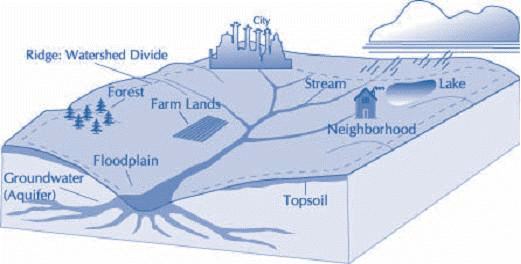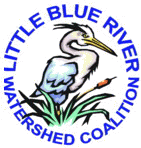|
Helpful
Definitions: |
|
|
|
|
Watershed:
the total land area from
which water drains into a particular stream or river
|
 |
|
Best Management
Practices (BMPs):
stormwater management and conservation practices that
have demonstrated to effectively control movement of
pollutants, prevent degradation of soil and water
resources, and that are compatible with the land use.
BMPs can be divided into two categories: structural and
non-structural.
-
Structural BMPs
can be thought of as engineering solutions to stormwater
management (Ex. stormwater ponds and open channels).
-
Non-structural BMPs
have no physical structures, but are designed to limit
the amount of pollutants available in the environment
that would potentially end up in stormwater runoff.
Non-structural BMPs can be achieved through such things
as education, management, and development practices.
Some examples include ordinances and practices
associated with land use and comprehensive site
planning.
|
|
Impervious Surface:
a surface which does not
easily allow the infiltration or penetration of water.
During rainstorm events, a large percentage of water
will runoff. Examples include roof tops, paved walks,
roadways, driveways, sidewalks, etc.
|
|
Pervious Surface:
a surface which allows
infiltration or penetration of water. During rainstorm
events a percentage of water will infiltrate into the
surface with the remaining storm water running off. The
percentage runoff is dependent on the type, slope,
percent saturation, etc. of the surface. Examples
include lawns, farm fields, parks, wooded areas, golf
courses, etc.
|
|
Stormwater Runoff:
When it rains or snows,
runoff picks up and carries a wide variety of pollutants
into our storm water system. These pollutants then flow
into our local waterways. The U.S. Environmental
Protection Agency estimates that at least 50 percent of
our nation's water pollution is caused by storm water
runoff.
|
|
Low Impact
Development (LID):
an ecological friendly
approach to site development and storm water management
that aims to mitigate developmental impacts to land,
water, and air. The approach emphasizes the integration
of site design and planning techniques that conserve the
natural systems and hydrologic functions of a site.
|
|
Nonpoint Source Pollution (NPS):
Nonpoint pollution is the
pollution of our nation's waters caused by rainfall or
snowmelt moving over and through the ground. As the
runoff moves, it picks up and carries away natural
pollutants and pollutants resulting from human activity,
finally depositing them into lakes, rivers, wetlands,
coastal waters, and ground waters. In addition,
hydrologic modification is a form of nonpoint source
pollution that often adversely affects the biological
and physical integrity of surface waters.
|
|
Green Infrastructure:
the network of open space,
woodlands, wildlife habitat, parks and other natural
areas, which sustain clean air, water, and natural
resources and enrich their citizens' quality of life.
|
|
Primary
Functions of BMPs: (definitions related to
stormwater runoff functions)
Infiltration:
the percolation of
water into the ground. The
soil texture and structure, vegetation types and
cover, water content of the soil, soil temperature,
and rainfall intensity all play a role in dictating
infiltration rate and capacity.
Capture:
the collection of
water into a designed treatment practice rather than
allowing runoff
Filtration:
a BMP that filters
pollutants from runoff, either through a natural
(plant uptake) or designed process (sand, etc).
Storage:
the collection and
holding of runoff water volume to control flow
Conveyance:
the process of water moving from one place to another
|
|
|

